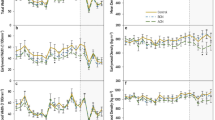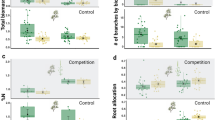Abstract
The above-ground biomass and nutrient accumulation by poplar plantations were evaluated for pulpwood production in China. Experimental treatments applied in a split-plot design included four planting densities (1111, 833, 625 and 500 stems·hm−2), three rotation lengths (4a, 5a and 6a) and three poplar clones (I-69, NL-80351 and I-72). The highest biomass was achieved in the highest stocked stand (1111 stem·hm−2) at 6 of rotation age for both clone I-69 and clone I-72, which is about two times that in the stands of 500 stems·hm−2 at 4 of rotation age. However, the highest occurred in the stand of 833 stems·hm−2 at 6-year rotation for NL-80351. Ranking of the plantation biomass production by component was stem>branches>foliage>stem-bark and the production of the support components of the plantation was 10-fold that of the productive component, i.e., foliage. The pattern of accumulation of nutrients by the plantations was similar to the biomass. Nutrient accumulation in the plantations was in the order of Ca>N>K>Mg>P, but some differences existed in annual nutrient accumulation rates for four planting densities and three poplar clones. The mean annual accumulation of N and P in the plantations was 13.2 and 2.8 kg·hm−2 in stem, 12.1 and 1.9 kg·hm−2 in branch, and 98.5 and 9.5 kg·hm−2 in foliage. The mean Ca, K and Mg accumulations were 28.2, 18.5 and 2.9 kg·hm−2·a−1, 26.9, 11.0 and 2.3 kg·hm−2·a−1 in branch, and 116.5, 81.3 and 16.1 kg·hm−2·a−1 in foliage, respectively. Biomass utilization standards markedly affected the export of nutrients from the site. Whole tree utilization yields the most biomass and removes the most nutrients. Removal of stem with ≥10-cm diameter exports about half of the biomass, but N and nutrients removals are only 23% and 28% of the total, respectively. Removal of the entire stem provides about two-thirds of the total biomass and removes 31.1% total N and 37.5% total nutrients respectively. Including the branches in the removal increases biomass yield to 92% of the total, and nutrient removal is about 68% of the total.
Similar content being viewed by others
References
Baker, J.B., Blackmon, B.G. 1977. Biomass and nutrient accumulation in a cottonwood plantation—the first growing season. Soil Sci. Soc. Am. Jour.,41: 632–636.
Fang Shengzuo, Lu Shixing, Xu Xizeng,et al. 1997. A case study on agroforestry management systems: effects of new poplar-crop interplanting patterns on biomass productivity, crop quality and economic benefits. Pp. 71–78 in: Volume 1. Forest and tree resources”, Proceedings of the XI World Forestry Congress, Antalya, Turkey 13–22 October 1997.
Fang Shengzuo, Xu Xizeng, San Xinshou,et al. 1996. The biomass productivity and wood quality of eastern cottonwood in minirotation management systems. Scientia Silvae Sinicae,32(4): 334–341.
Fang Shengzuo, Cao Fuliang, Zhu Yijun. 1993. The present situation and prospect of short-rotation management system in poplars. Journal of Nanjing Forestry University,17(add.): 50–55
FAO. 1979. Poplars and willows in wood production and land use. Forestry Series No. 10. Food and Agric. Organ., Rome, 328pp
Freedman, B., Movash, R., Hanson, A.J. 1981. Biomass and nutrient removals by conventional and whole-tree clear-cutting of a red spruce-balsam fir stand in Central Nova Scotia. Can. J. For. Res., (11): 249–257.
Gambles, R.L., Zsuffa, L. 1984. Conversion and use of poplar and willow biomass for food, forage and energy in North America. International Poplar Commission, October, 1984, Room, Fo: MISC/84/15
Issac, R.A., Kerber, J.D. 1971. Atomic absorption and flame photometry: techniques and uses in soil, plant, and water analysis. Pp. 17–37 in Walsh, L.M. (Ed.) Instrumental Methods for Analysis of Soils and Plant Tissues. Soil Sci. Soc. Amer., Madison, WI. 222pp
Jackson, M.L. 1958. Soil Chemical Analysis. Prentice-Hall Englewood Cliffs, NJ, 492pp
Kimmins, J.P. 1997. Evaluation of the consequences for future tree productivity of the loss of nutrients in whole-tree harvesting. For. Ecol. Manag. (1): 169–183.
Kinard, R.M., Johnson, R.L. 1980. Fifteen years of cotton-wood plantation growth and yield. Southern Journal of Applied Forestry,4: 180–185
Lu ShiXing, Xu Xizeng, Wang Mingxing.et al. 1989. A study on the planting density of the man-made poplar forests. in: Symposium on Techniques of Fast-growing and High Yield for Southern Type Clones of Aigeiros Section. Beijing: Academic Book & Periodical Press, Pp. 72–80.
Lu Shixing, Xu Xizeng, Cao, Fulianget al. 1997. A study on biomass productivity for short-rotation management of poplar clones. in: Lu, Shixinget al (Ed.) Research and Practice on Poplar Industrial Plantations. Beijing: China Forestry Publishing House, Pp. 58–63
Moran, L.A., Nautryal, J.G. 1985. Present and future of feasibility of short-rotation energy farm in Ontario. Forest Ecology and Management,10: 323–328
Shelton, M.G., Switzer, G.L., Nelson, L.E.,et al. 1982: The development of cottonwood plantations on alluvial soils. Mississippi State University, Technical Bulletin 113, 46 pp.
Smith, C.T., Dyck, W.J., Beet, P.N.,et al. 1994. Nutrition and productivity of pinus raduata following harvest disturbance and fertilisation of coastal sand dunes. For. Ecol. Manag.,66: 5–38.
Smith, C.T., Lowe, A.T., Beet, P.N.,et al. 1994: Nutrient accumulation in second-rotationPinus radiata after harvest residue management and fertilizer treatment of coastal sand dunes. New Zealand Journal of Forestry Sciences24(2/3): 362–389
Xu Xizeng & Fang Shengzuo. 1997. A review of short-rotation cultivation for poplar clones. in: Lu Shixing, Fang Shengzuo, Xu, XiZeng (Ed.) Research and Practice on Poplar Industrial Plantations. Beijing: China Forestry Publishing House, Pp. 1–9
Xu Xizeng & Lu Shixing. 1989. A study on the productive capacity and economic effect of agroforestry complex. in: Symposium on Techniques of Fast-growing and High Yield for Southern Type Clones of the Aigeiros Section. Beijing: Academic Book & Periodical Press, Pp. 56–71
Author information
Authors and Affiliations
Additional information
This paper is a part of “Selection and culture of new varieties for poplar industrial forests” which is one of national key tasks in the Ninth Five-Year Plan.
Responsible editor: Chai Ruihai
Rights and permissions
About this article
Cite this article
Shengzuo, F., Xizeng, X., Shixing, L. et al. Impact of spacing and rotation length on nutrient budgets of poplar plantations for pulpwood. Journal of Forestry Research 10, 133–140 (1999). https://doi.org/10.1007/BF02855419
Received:
Issue Date:
DOI: https://doi.org/10.1007/BF02855419




